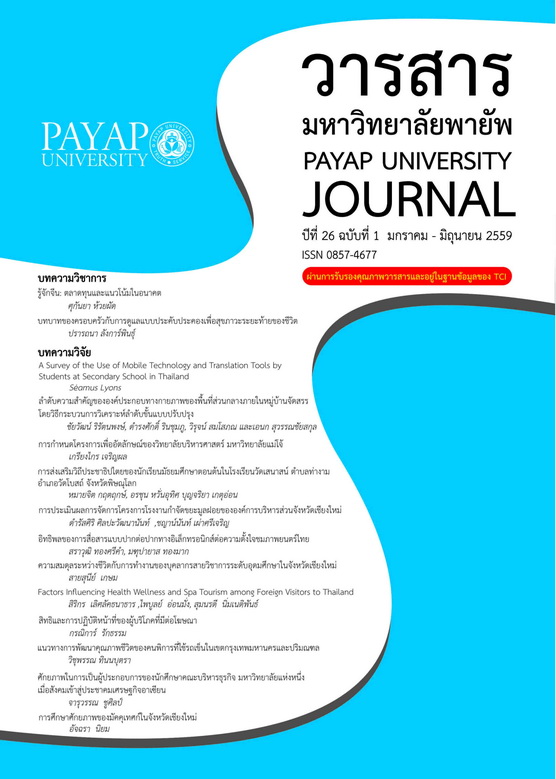การประเมินผลการจัดการโครงการโรงงานกำจัดขยะมูลฝอยขององค์การบริหารส่วนจังหวัดเชียงใหม่
Main Article Content
บทคัดย่อ
การจัดการขยะมูลฝอย เป็นประเด็นที่ทวีความท้าทายในหลายประเทศทั่วโลกโดยเฉพาะอย่างยิ่งประเทศที่กำลังพัฒนาและเปลี่ยนผ่านสู่โลกสมัยใหม่ ซึ่งสะท้อนให้เห็นถึงการจัดการขยะมูลฝอยที่ไม่เหมาะสม การใช้เทคโนโลยีที่ล้าสมัยภายใต้สภาวะเศรษฐกิจที่ย่ำแย่ การขาดความตระหนักและสำนึกที่ดีต่อการดูแลสภาพแวดล้อม จึงส่งผลกระทบอันน่าสะพึงกลัวต่อสภาพแวดล้อมของโลก บทความวิจัยนี้มีวัตถุประสงค์เพื่อแสดงผลการศึกษา (1) สภาวะแวดล้อมของโครงการโรงงานกำจัดขยะมูลฝอยเพื่อคัดแยกและทำปุ๋ยชีวภาพขององค์การบริหารส่วนจังหวัดเชียงใหม่ (2) ความเหมาะสมของปัจจัยนำเข้า (Input) และกระบวนการการจัดการโครงการโรงงานกำจัดขยะมูลฝอยฯ (3) ผลผลิตของโครงการโรงงานกำจัดขยะมูลฝอยฯ และ (4) ความรู้ความเข้าใจและพฤติกรรมการจัดการขยะมูลฝอยของประชาชนในพื้นที่โดยรอบโครงการโรงงานกำจัดขยะมูลฝอยฯ เพื่อนำเสนอผลการศึกษาให้แก่องค์กรปกครองส่วนท้องถิ่นเพื่อใช้เป็นข้อมูลในการทบทวนโครงการ และการจัดการขยะมูลฝอยในครัวเรือนของประชาชนโดยรอบโครงการโรงงานกำจัดขยะมูลฝอยฯ เครื่องมือที่ใช้ในการเก็บรวบรวมข้อมูล ได้แก่ แบบสอบถาม แบบสัมภาษณ์ การประชุมกลุ่มโดยใช้เทคนิคการระดมสมอง และการเดินทางไปศึกษาดูงานในพื้นที่ที่ประสบความสำเร็จในการจัดการขยะมูลฝอยการวิเคราะห์ข้อมูลใช้สถิติเชิงพรรณนา และแบบจำลองซิปป์ ผลการศึกษาพบว่า การจัดการโครงการขององค์การบริหารส่วนจังหวัดเชียงใหม่มีปัจจัยสนับสนุนที่เป็นจุดแข็ง (ค่าเฉลี่ยความเหมาะสมอยู่ที่ระดับมากขึ้นไป)ที่องค์กรปกครองส่วนท้องถิ่นและองค์การบริหารส่วนจังหวัดเชียงใหม่ควรร่วมกันนำไปใช้เป็นแนวทางในการดำเนินการจัดการโครงการโรงงานกำจัดขยะมูลฝอยฯต่อไป ได้แก่ (1) ด้านสภาวะแวดล้อมโดยรวมมีความสอดคล้องระดับมาก ค่าเฉลี่ยเท่ากับ 4.19 (2) ด้านปัจจัยนำเข้า ในภาพรวมมีความเหมาะสมในภาพรวมระดับมาก ค่าเฉลี่ยเท่ากับ 4.54 และด้านกระบวนการในภาพรวมมีความเหมาะสมระดับมาก ค่าเฉลี่ยเท่ากับ 3.70 อย่างไรก็ตาม ปัจจัยเสี่ยงซึ่งเป็นจุดบกพร่อง (ปัจจัยที่มีความเหมาะสมปานกลาง-น้อยที่สุด) ที่องค์กรปกครองส่วนท้องถิ่นและองค์การบริหารส่วนจังหวัดเชียงใหม่จักต้องร่วมกันปรับปรุงแก้ไขเพื่อลดปัญหาที่เกิดขึ้น ได้แก่ ผลกระทบด้านมลภาวะที่มีความรุนแรงในระดับปานกลาง ค่าเฉลี่ยในภาพรวมเท่ากับ 3.21 ทั้งนี้ประชาชนในพื้นที่โดยรอบโครงการโรงงานกำจัดขยะมูลฝอยฯมีความรู้ความเข้าใจเกี่ยวกับการจัดการขยะมูลฝอยในทุกประเด็น (ร้อยละ 93.23) และมีพฤติกรรมที่พึงประสงค์ในทุกประเด็นตามหลักการจัดการขยะมูลฝอยที่ถูกต้องดังนั้นแนวทางการจัดการขยะมูลฝอยในระยะสั้นองค์กรปกครองส่วนท้องถิ่นและประชาชนควรร่วมกับองค์การบริหารส่วนจังหวัดเชียงใหม่ในการคงไว้ซึ่งปัจจัยสนับสนุนความสำเร็จของการจัดการโครงการโรงงานกำจัดขยะมูลฝอยฯ (จุดแข็ง) และร่วมกันกำหนดกติกาในการจัดการโครงการโรงงานกำจัดขยะมูลฝอยฯ เพื่อใช้ดำเนินงานต่อไปและจักต้องปรับปรุงแก้ไขปัจจัยเสี่ยง (จุดบกพร่อง) เพื่อแก้ไขปัญหาที่เกิดขึ้น ส่วนการแก้ไขปัญหาระยะยาว องค์กรปกครองส่วนท้องถิ่นควรใช้กลุ่มประชาชนบ้านร้องขี้เหล็ก ตำบลเชิงดอย อำเภอดอยสะเก็ด จังหวัดเชียงใหม่ (กลุ่มที่ได้รับเลือกเป็นตัวแทนไปศึกษาดูงานในพื้นที่ที่ประสบความสำเร็จในการจัดการขยะมูลฝอย) เป็นกลุ่มนำร่องในการจัดการขยะมูลฝอยในครัวเรือนด้วยตนเองโดยน้อมนำเอาหลักเศรษฐกิจพอเพียงมาประยุกต์ใช้ให้เหมาะสมกับพื้นที่
Article Details
เอกสารอ้างอิง
ดำรัสศิริ ศิลปวัฒนานันท์และชญาน์นันท์ เผ่าศรีเจริญ. (2555). การประเมินผลการจัดการโครงการโรงงานกำจัดขยะมูลฝอยเพื่อคัดแยกและทำปุ๋ยชีวภาพขององค์การบริหารส่วนจังหวัดเชียงใหม่. รายงานการวิจัย. สำนักวิจัย มหาวิทยาลัยพายัพ.
เทศบาลตำบลเมืองแกลง. ศูนย์ประสานงานเครือข่ายการเรียนรู้ด้านการจัดการเมืองและสิ่งแวดล้อมประจำภาคตะวันออก. ค้นแนวคิด พบมรรควิธี ปรุงเมืองให้น่าอยู่อย่างแยบยล. เอกสารประชาสัมพันธ์เทศบาลตำบลเมืองแกลง.
นิรันดร์ พงษ์ธัญญการ. (2547). การจัดการขยะมูลฝอยในนิคมอุตสาหกรรมบางปูโดยใช้กระบวนการสิ่งแวดล้อมศึกษา กรณีศึกษา: โรงงานอุตสาหกรรม บริษัทอุตสาหกรรมกรดมะนาว จำกัด. วิทยานิพนธ์ มหาวิทยาลัยราชภัฏพระนคร.
นุชนรินทร์ ช้างป่าดี. (2550). การเรียกร้องประชาพิจารณ์นโยบายสาธารณะ: กรณีศึกษาโครงการก่อสร้างโรงงานกำจัดขยะมูลฝอยครบวงจร ตำบลป่าป้อง อำเภอดอยสะเก็ด จังหวัดเชียงใหม่. การค้นคว้าแบบอิสระ มหาวิทยาลัยเชียงใหม่
บุญรัตน์ หาญชัย. การสัมภาณ์ส่วนบุคคล. มิถุนายน 2557.
ปัญญาพล มงคลเจริญ. การสัมภาษณ์ส่วนบุคคล. เมษายน 2556.
พีรยา วัชโรทัย. (2556). การจัดการขยะขององค์กรปกครองส่วนท้องถิ่น: กรณีศึกษาเทศบาลตำบลเมืองแกลง จังหวัดระยอง. วิทยานิพนธ์ วิทยาศาสตรมหาบัณฑิต (สาขาการจัดการสิ่งแวดล้อม) คณะพัฒนาสังคมและสิ่งแวดล้อม สถาบันบัณฑิตพัฒนบริหารศาสตร์.
มหาวิทยาลัยเชียงใหม่. (2553). โครงการสร้างความเข้มแข็งแก่ประชาชนในการแก้ไขปัญหาวิกฤตหมอกควัน กิจกรรมการพัฒนาประชาชนเป็นแหล่งเรียนรู้การแก้ไขปัญหามลภาวะหมอกควันในประชาชน, สืบค้นเมื่อวันที่ 12 ตุลาคม 2557. http://www.pol.cmu.ac.th/images/editor/files/smog/green/manual-ii.pdf.
สุธาวัลย์ เสถียรไทย. (2554). ปรัชญาของเศรษฐกิจพอเพียงกับสังคมไทย. ปรัชญาของเศรษฐกิจพอเพียงกับการจัดการสิ่งแวดล้อม, 249-260.
สุรีย์ บุญญานุพงศ์. (2549). การบริหารจัดการระบบกำจัดขยะแบบศูนย์รวมขององค์กรปกครองส่วนท้องถิ่น. รายงานการวิจัย.
สุวจี แตงอ่อน. (2557). แนวทางพัฒนาชุมชนต้นตาลเพื่อเตรียมรับภาวะโลกร้อนในแนวทางปรัชญาของเศรษฐกิจพอเพียง. วารสารการพัฒนาชุมชนและคุณภาพชิวิต เครือข่ายบริหารการวิจัย, 2 (1), 24-25.
สำนักงานกองทุนสนับสนุนการวิจัย. (2552). การสร้างกลยุทธ์การจัดการขยะโดยการมีส่วนร่วมของประชาชนบ้านนาบอน หมู่ 2 ตำบลบ่องาม อำเภอเสริมงาม จังหวัดลำปาง. สืบค้นเมื่อวันที่ พฤษภาคม 2555. http://wwwtrf.or.th/RE/X.asp?Art_ID=309
อนุชิต ไชยถา. (2552). ประสิทธิภาพการจัดการขยะมูลฝอยของเทศบาลตำบลดอยสะเก็ด จังหวัดเชียงใหม่. การค้นคว้าแบบอิสระ มหาวิทยาลัยเชียงใหม่.
Topic, Milan and Biedermann, Hubert. (2015). “Planning ofintegrated/sustainable solid waste management (ISWM) – Model of integrated solid waste management in RepublikaSrpska” Serbian Journal of Management 10 (2), 255-267. สืบค้นเมื่อวันที่ 21 มีนาคม 2559. http://web.b.ebscohost.com/ehost/pdfviewer/pdfviewer?sid=d764f79c.


